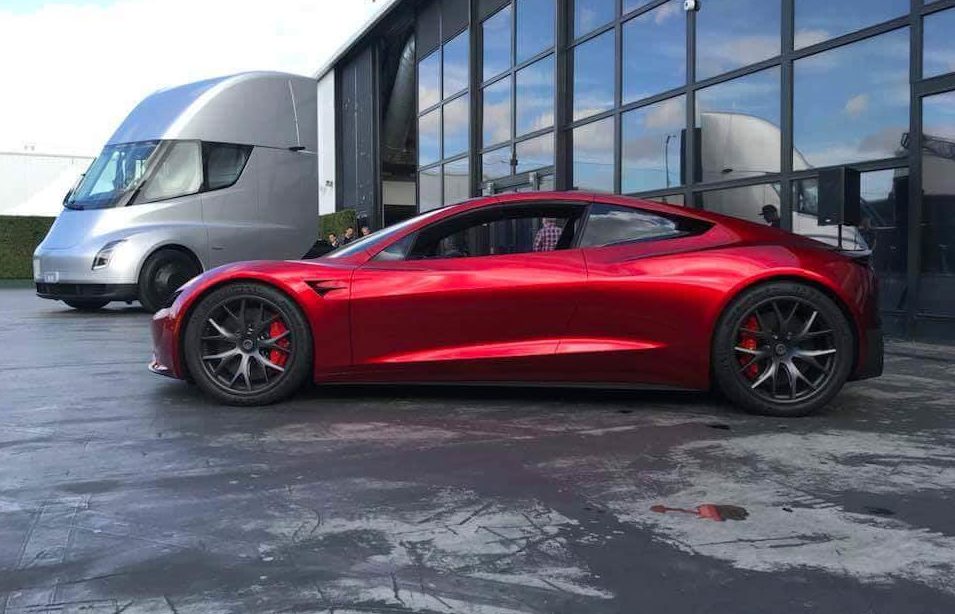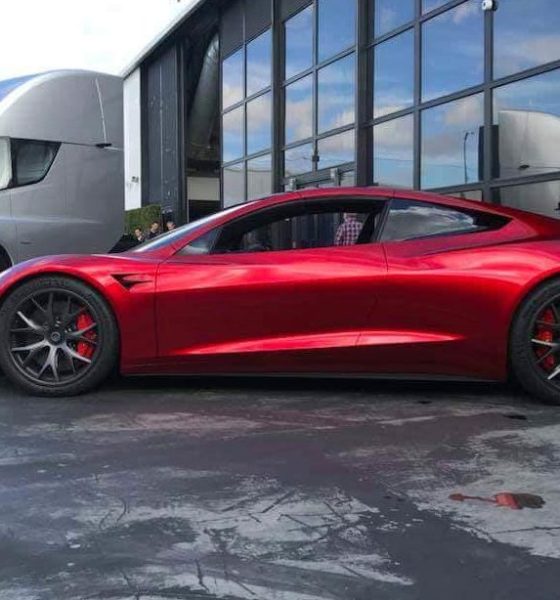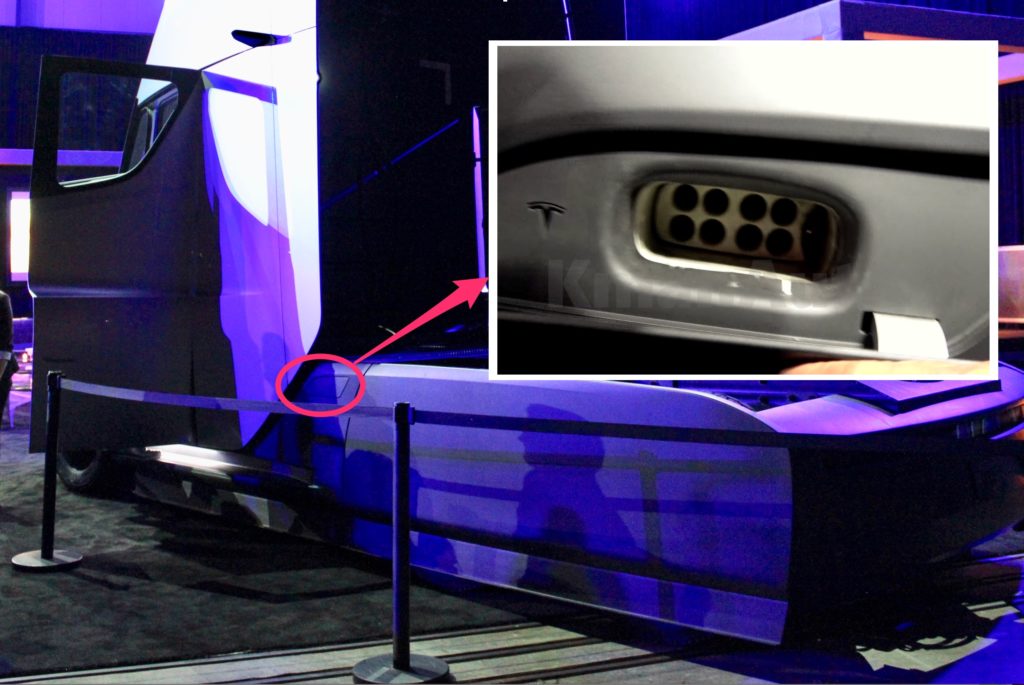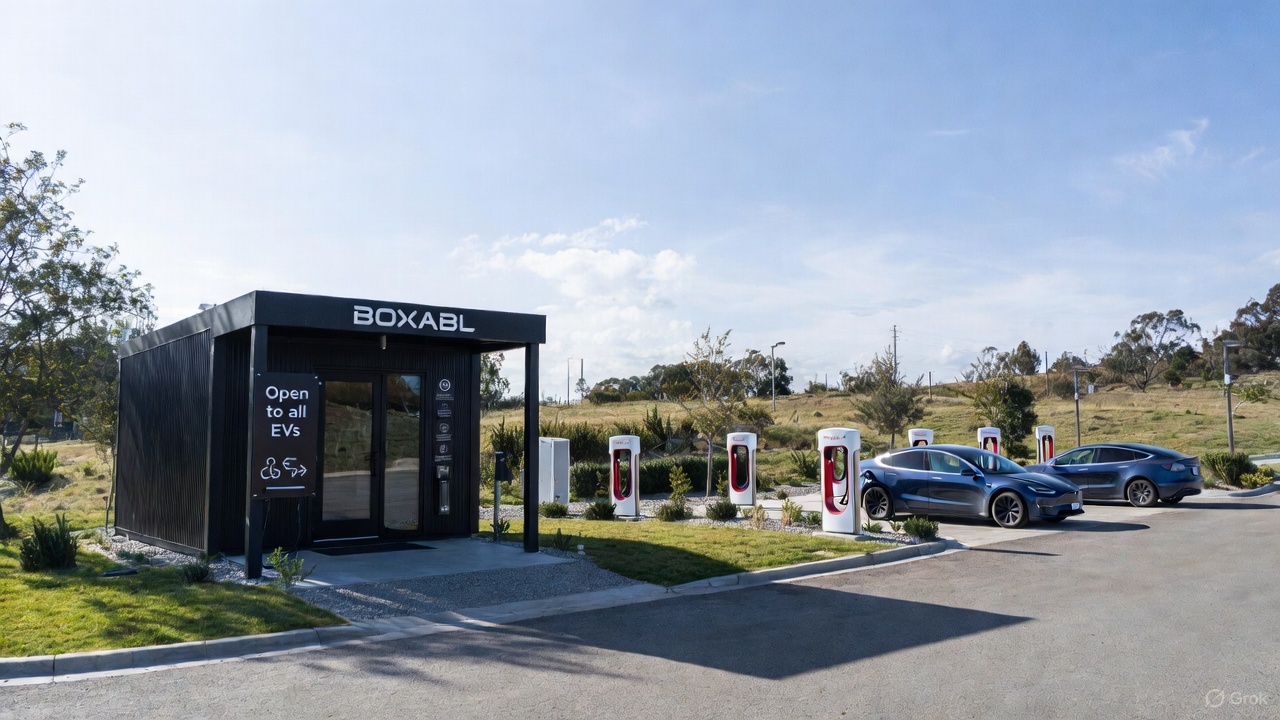

News
Tesla Semi and Roadster could be relying on a “battery breakthrough”
Elon Musk and Tesla have made some bold claims for the new Tesla Semi and Roadster. Those who understand batteries have been scratching their heads trying to figure out how the company can deliver the specs it’s promising – and concluding that the only possible way is some as-yet-unannounced advancement in battery technology.
Musk says the Tesla Semi will be able to haul 80,000 pounds for 500 miles, and recharge to 400 miles in 30 minutes, which would revolutionize the trucking industry. As for the Roadster, its promised 0-60 acceleration of 1.9 seconds effectively shuts down every one of the world’s baddest supercars, and its touted 620-mile range would be double that of any EV produced to date.
However, industry experts are questioning Tesla CEO Elon Musk’s touted range and charging capabilities, saying the specifications defy current physics and battery economics.
According to Bloomberg, analysts at Bloomberg New Energy Finance point out that Tesla Semi’s announced specs would require a battery capacity of between 600 and 1,000 kilowatt hours (6-10 times the size of the largest Model S battery). Using current technology, an 800 kWh battery pack would weigh over 10,000 pounds and cost more than $100,000. That’s just for the battery – Tesla has said its entire truck will start at $150,000. It seems plain that Tesla is counting on falling battery prices to square the circle. “The first Tesla Semis won’t hit the road until late 2019,” Bloomberg points out. “Even then, production would probably start slowly. Most fleet operators will want to test the trucks before considering going all-in. By the time Tesla gets large orders, batteries should cost considerably less.”
It isn’t just the capacity of the battery that’s causing analysts to wear out their calculators – Musk’s claim that the Tesla Semi will be able to add 400 miles of charge in 30 minutes would require a charging system 10 times more powerful than Tesla’s current Supercharger – which is already by far the most powerful in the industry.

Tesla Semi Megacharger port could support 1 MW of power.
“I don’t understand how that works,” said Bloomberg New Energy Finance EV Analyst Salim Morsy. “I really don’t.” Tesla’s current generation of Superchargers have a power output of 120 kilowatts and can add about 180 miles of range to a Model S battery in 30 minutes. To meet Tesla’s charging claim for the Semi would require the promised Megacharger to deliver an output of at least 1,200 kW.
Perhaps Tesla’s biggest bombshell is the promise that it will guarantee truckers electricity rates of 7 cents per kilowatt hour, which Bloomberg estimates could translate to fuel savings of up to $30,000 a year. Musk says that adding solar panels and battery packs at the charging stations will account for at least part of the cost reduction. However, BNEF’s Salim Morsy insists that Tesla will have to heavily subsidize those electricity rates – he estimates that Tesla will pay a minimum of 40 cents per kWh. “There’s no way you can reconcile 7 cents a kilowatt hour with anything on the grid that puts a megawatt hour of energy into a battery,” Morsy said. “That simply does not exist.”
Of course, that’s no different from what Tesla does for its current Supercharger network, offering free electricity to many customers, while paying almost $1 per kWh to produce it, according to Morsy’s estimate.
And how about that Roadster? To deliver its promised range of 620 miles, it will need a 200 kWh battery pack, twice the size of Tesla’s largest currently available pack. Mr. Morsy predicts that Tesla will stack two battery packs, one on top of the other, beneath the Roadster’s floor.
Even with a double-decker pack however, it’s hard to escape the conclusion that Tesla is counting on improving battery tech to make the Roadster, like the Semi, feasible. Battery density has been improving at a rate of about 7.5 percent a year, and that’s without any major breakthrough in battery chemistry.
“The trend in battery density is, I think, central to any claim Tesla made about both the Roadster and the Semi,” Morsy said. “That’s totally fair. The assumptions on a pack in 2020 shouldn’t be the same ones you use today.”
A massive battery pack not only enables greater range – it’s also a key element in the Roadster’s world-beating 0-60 acceleration. Jalopnik’s David Tracy spoke with battery expert Venkat Viswanathan, a Mechanical Engineering Assistant Professor at Carnegie Mellon, who says that the 1.9-second figure actually seems reasonable.
Viswanathan explains that the power output of a motor is limited by the power draw from each battery cell. Because the Roadster’s pack is double the size, the power draw may not be that much more than that of a Ludicrous Model S.
Viswanathan told Jalopnik that the most modern battery cells offer specific energy of about 240 watt-hours per kilogram. Using that assumption, the Roadster’s 200 kWh battery pack should weigh roughly 1,800 pounds, a huge advance over the previous-generation Roadster. With clever use of lightweight materials, the Roadster could still come out under the nearly two-ton curb weight of the Nissan GT-R, an acceleration benchmark among sports cars.
Viswanathan concludes that a 0-60 time of 1.9 seconds and a range of 620 miles are quite feasible, although there are several other factors that will come into play – much depends on the vehicle’s tires and aerodynamics.
Meanwhile, at least one analyst thinks Tesla’s latest revelations (or claims, or fantasies, depending on your point of view) have implications that go far beyond the Semi and the Roadster. Michael Kramer, a Fund Manager with Mott Capital Management, told Marketwatch that he suspects improved battery capacities and charging times could make their way into all future Tesla vehicles.
“I’d have to imagine that Tesla has figured out how to put this technology on all of their cars, which means every car could get a full charge in under 30 minutes,” Kramer wrote. Once the Model S “is equipped with the 200 kWh battery pack in the new Roadster, which I can’t imagine is too far down the road, the range issue for the Tesla is officially dead.” (Elon Musk has said that Models S and X will not get physically larger packs, but improved energy density could increase capacity while keeping the size of the pack the same.) Someday soon, Kramer says, “The Model S would likely be able to drive further on one charge than a car on a full tank of gasoline.”
===
Note: Article originally published on evannex.com, by Charles Morris

News
Tesla discloses interesting collaboration partner for Supercharging
This BOXABL collaboration would be a great way to add a rest stop to a rural Supercharging location, and could lead to more of these chargers across the U.S.

Tesla disclosed an interesting collaboration partner in an SEC filing, which looks like an indication of a potential project at Supercharger sites.
Tesla said on Tuesday in the filing that it was entering an agreement with BOXABL to design and build a Micromenity structure. Simply put, this is a modular building, usually a few hundred square feet in size, and it has been seen at Superchargers in Europe.
In Magnant, France, Tesla opened a small building at a Supercharger that is available to all EV owners. There are snacks and drinks inside, including ice cream, coffee, a gaming console, and restrooms. It gives people an opportunity to get up and out of their cars while charging.
This building was not built by BOXABL, but instead by bk World Lounges. It is likely the final Supercharging stop before people get to Paris, as it is located 250 kilometers, or 155 miles, from the City of Light.
Voir cette publication sur Instagram
Magnant has 56 stalls, so it is a large Supercharging stop compared to most. The building could be a sign of things to come, especially as Tesla has opened up larger Supercharger stations along major roadways.
It is for just a single building, as the Scope of Work within the filing states “a comprehensive package for one Micromenity building.”
NEWS: BOXABL, a company that creates modular, prefabricated buildings, has entered into an agreement with @Tesla.
This is Tesla formally contracting BOXABL to design, engineer, and build a pilot “Micromenity” structure, a compact, modular building unit.
While some info in the… pic.twitter.com/RabJczGpEp
— Sawyer Merritt (@SawyerMerritt) December 9, 2025
Superchargers are commonly located at gas stations, shopping centers, and other major points of interest. However, there are some stops that are isolated from retail or entertainment.
This BOXABL collaboration would be a great way to add a rest stop to a rural Supercharging location, and could lead to more of these chargers across the U.S.
Tesla has done a lot of really great things for Supercharging this year.
Along with widespread expansion, the company launched the “Charging Passport” this week, opened the largest Supercharger in the world in Lost Hills, California, with 168 chargers, opened the Tesla Diner, a drive-in movie restaurant in Los Angeles, and initiated access to the infrastructure to even more automakers.
Elon Musk
Tesla CEO Elon Musk confirms Robotaxi safety monitor removal in Austin: here’s when
Musk has made the claim about removing Safety Monitors from Tesla Robotaxi vehicles in Austin three times this year, once in September, once in October, and once in November.

Tesla CEO Elon Musk confirmed on Tuesday at the xAI Hackathon that the company would be removing Safety Monitors from Robotaxis in Austin in just three weeks.
This would meet Musk’s timeline from earlier this year, as he has said on several occasions that Tesla Robotaxis would have no supervision in Austin by the end of 2025.
On Tuesday, Musk said:
“Unsupervised is pretty much solved at this point. So there will be Tesla Robotaxis operating in Austin with no one in them. Not even anyone in the passenger seat in about three weeks.”
Musk has made the claim about removing Safety Monitors from Tesla Robotaxi vehicles in Austin three times this year, once in September, once in October, and once in November.
In September, he said:
“Should be no safety driver by end of year.”
The safety driver is just there for the first few months to be extra safe.
Should be no safety driver by end of year.
— Elon Musk (@elonmusk) September 4, 2025
On the Q3 Earnings Call in October, he said:
“We are expecting ot have no safety drivers in at least large parts of Austin by the end of this year.”
Finally, in November, he reiterated the timeline in a public statement at the Shareholder Meeting:
“I expect Robotaxis to operate without safety drivers in large parts of Austin this year.”
Currently, Tesla uses Safety Monitors in Austin in the passenger’s seat on local roads. They will sit in the driver’s seat for highway routes. In the Bay Area ride-hailing operation, there is always a Safety Monitor in the driver’s seat.
Three weeks would deliver on the end-of-year promise, cutting it close, beating it by just two days. However, it would be a tremendous leap forward in the Robotaxi program, and would shut the mouths of many skeptics who state the current iteration is no different than having an Uber.
Tesla has also expanded its Robotaxi fleet this year, but the company has not given exact figures. Once it expands its fleet, even more progress will be made in Tesla’s self-driving efforts.
News
SpaceX reportedly mulling IPO, eyeing largest of all time: report
“I do want to try to figure out some way for Tesla shareholders to participate in SpaceX. I’ve been giving a lot of thought to how to give people access to SpaceX stock,” Musk said.

SpaceX is reportedly mulling an initial public offering, eyeing what would be the largest valuation at the time of availability of all time, a new report from Bloomberg said on Tuesday.
It is one of many reports involving one of Elon Musk’s companies and a massive market move, as this is not the first time we have seen reports of an IPO by SpaceX. Musk himself has also dispelled other reports in the past of a similar nature, including an xAI funding round.
SpaceX and Musk have yet to comment on the report. In the past, untrue reports were promptly replied to by the CEO; this has not yet gained any response, which is a good sign in terms of credibility.
However, he said just a few days ago that stories of this nature are inaccurate:
“There has been a lot of press claiming SpaceX is raising money at $800B, which is not accurate. SpaceX has been cash flow positive for many years and does periodic stock buybacks twice a year to provide liquidity for employees and investors. Valuation increments are a function of progress with Starship and Starlink and securing global direct-to-cell spectrum that greatly increases our addressable market. And one other thing that is arguably most significant by far.”
There has been a lot of press claiming @SpaceX is raising money at $800B, which is not accurate.
SpaceX has been cash flow positive for many years and does periodic stock buybacks twice a year to provide liquidity for employees and investors.
Valuation increments are a…
— Elon Musk (@elonmusk) December 6, 2025
Musk has discussed a potential IPO for SpaceX in recent months, as the November 6 shareholder meeting, as he commented on the “downsides” of having a public company, like litigation exposure, quarterly reporting pressures, and other inconveniences.
Nevertheless, Musk has also said he wants there to be a way for Tesla shareholders to get in on the action. At the meeting in early November, he said:
“I do want to try to figure out some way for Tesla shareholders to participate in SpaceX. I’ve been giving a lot of thought to how to give people access to SpaceX stock.”
Additionally, he added:
“Maybe at some point., SpaceX should become a public company despite all the downsides of being public.”
Musk has been historically reluctant to take SpaceX public, at times stating it could become a barrier to colonizing Mars. That does not mean it will not happen.
Bloomberg’s report cites multiple unidentified sources who are familiar with the matter. They indicate to the publication that SpaceX wants to go public in mid-to-late 2026, and it wants to raise $30 billion at a valuation of around $1.5 trillion.
This is not the first time SpaceX has discussed an IPO; we reported on it nine years ago. We hope it is true, as the community has spoken for a long time about having access to SpaceX stock. Legendary investor Ron Baron is one of the lucky few to be a SpaceX investor, and said it, along with Tesla, is a “lifetime investment.”
Tesla bull Ron Baron reveals $100M SpaceX investment, sees 3-5x return on TSLA
The primary driver of SpaceX’s value is Starlink, the company’s satellite internet service. Starlink contributes 60-70 percent of SpaceX’s revenue, meaning it is the primary value engine. Launch services, like Falcon 9 contracts, and the development of Starship, also play supporting roles.








